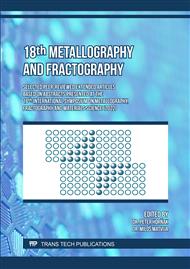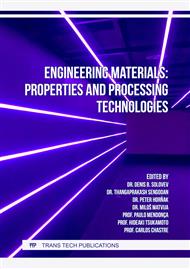[1]
K. Bobzin et al., CrN/AlN and CrN/AlN/Al2O3 coatings deposited by pulsed cathodic arc for aluminum die casting applications. Surface & Coatings Technology 284 (2015) 222-229.
DOI: 10.1016/j.surfcoat.2015.07.074
Google Scholar
[2]
Ch. Changrong et al., Energy based approach to thermal fatigue life of tool steels for die casting dies. In: International Journal of Fatigue Volume 92, Part 1, November 2016, 166-178.
DOI: 10.1016/j.ijfatigue.2016.06.016
Google Scholar
[3]
J. Lin et al., Design methodology for optimized die coatings: The case for aluminum pressure die-casting In: Surface and Coatings Technology 201 (2006) 2930-2941.
DOI: 10.1016/j.surfcoat.2006.06.024
Google Scholar
[4]
K. Domkin et al., Modeling of high temperature- and diffusion-controlled die soldering in aluminum high pressure die casting, J. Mater. Process. Technol. 209 (8) (2009) 4051-4061.
DOI: 10.1016/j.jmatprotec.2008.09.031
Google Scholar
[5]
B. Trembach et al., Influence of the core filler composition on the recovery of alloying elements during the self-shielded flux-cored arc welding. J. of Mater. Res. and Tech. 9 (2020) 10520-10528.
DOI: 10.1016/j.jmrt.2020.07.052
Google Scholar
[6]
B. Trembach et al., Application of Taguchi method and ANOVA analysis for optimization of process parameters and exothermic addition (CuO-Al) introduction in the core filler during self-shielded flux-cored arc welding. Int. J. Adv. Manuf. Technol. 114 (2021) 1099-1118.
DOI: 10.1007/s00170-021-06869-y
Google Scholar
[7]
Z. W. Chen, M. Z. Jahedi, Die erosion and its effect on soldering formation in high pressure die casting of aluminium alloys, Mater. Des. 20 (6) (1999) 303-309.
DOI: 10.1016/s0261-3069(99)00035-7
Google Scholar
[8]
K. Venkatesan, R. Shivpuri, Experimental and numerical investigation of the effect of process parameters on the erosive wear of die casting dies, J. Mater. Eng. Perform. 4 (2) (1995) 166-174.
DOI: 10.1007/bf02664110
Google Scholar
[9]
A. Mohammed, M. B. Marshall, R. Lewis, Development of a method for assessing erosive wear damage on dies used in aluminium casting, Wear 332-333 (2015) 1215-1224.
DOI: 10.1016/j.wear.2014.12.038
Google Scholar
[10]
L. F. Hou, Y. H. Wei, Y. G. Li, B. S. Liu, H. Y. Du, C. L. Guo, Erosion process analysis of die-casting inserts for magnesium alloy components, Eng. Fail. Anal. 33 (2013) 457-564.
DOI: 10.1016/j.engfailanal.2013.06.018
Google Scholar
[11]
D. W. C. Baker, K. H. Jolliffe, D. Pearson, The resistance of materials to impact erosion damage, Philos. Trans. R. Soc. A Math. Phys. Eng. Sci. 260 (1110) (1966) 193-203.
Google Scholar
[12]
A. Persson, S. Hogmark, J. Bergström, Temperature profiles and conditions for thermal fatigue cracking in brass die casting dies, J. Mater. Process. Technol. 152 (2) (2004) 228-236.
DOI: 10.1016/j.jmatprotec.2004.04.241
Google Scholar
[13]
C. Rosbrook, Analysis of Thermal Fatigue and Heat Checking in Die-Casting Dies: A Finite Element Approach, PhD thesis Ohio State University, 1992.
Google Scholar
[14]
F. Medjedoub, G. Dour, S. Le Roux, P. Lamesle, M. Salem, P. Hairy, F. Rézaï-Aria, Experimental conditions and environment effects on thermal fatigue damage accumulation and life of die-casting steel X38CrMoV5 (AISI H11), Int. J. Microstruct. Mater. Propert. 3 (2-3) (2008).
DOI: 10.1504/ijmmp.2008.018739
Google Scholar
[15]
P. Hansson, "Modern pre-hardened tool steels in die-casting applications," Materials and Manufacturing Processes, 24 (7-8) (2009) 824-827.
DOI: 10.1080/10426910902841753
Google Scholar
[16]
Uddeholm, "Dievar," 2014, (18.10.2021) internet: http://www.uddeholm.com.
Google Scholar
[17]
D. Klobčar, J. Tušek, B. Taljat, Thermal fatigue of materials for die-casting tooling, Mater. Sci. Eng. A 472 (1) (2008) 198-207.
DOI: 10.1016/j.msea.2007.03.025
Google Scholar
[18]
D. Schwam, J. F. Wallace, and S. Birceanu, "Die Materials for Critical Applications and Increased Production Rates," Case Western Reserve University, 2002.
DOI: 10.2172/806823
Google Scholar
[19]
Methodical measurement and evaluation of adhesive cohesive behavior of thin film - substrate systems, 2005, (19.10.2021) internet: https://www.opi.zcu.cz/adheze.html.
Google Scholar
[20]
J. Tkáčová, E. Zdravecká, E. Evin, M. Tomáš, D. Jakubéczyová, Koroze a ochrana materiálu 63 (4) 159-166 (2019).
DOI: 10.2478/kom-2019-0021
Google Scholar
[21]
D. Klobčar, et al., Thermo fatigue cracking of die casting dies. In: Engineering Failure Analysis Volume 20, March 2012, 43-53.
DOI: 10.1016/j.engfailanal.2011.10.005
Google Scholar



